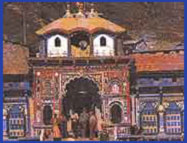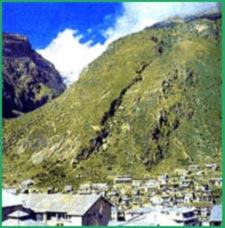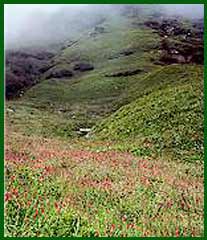| Destinations
|
|||
 Badrinath, located on the right bank of river Alaknanda, is a temple town that evokes the most intense religious feelings. An abode of seers, saints and yogis from time immemorial, Badrinath is one of the four Dhams that a devout Hindu has to visit in his lifetime to attain salvation. Known as 'Tapobhoomi' (land of meditation and penance) and 'Bhubaikunth' (heaven on earth), it is surrounded on either side, by two mountain ranges of Nar and Narayan, with the Neelkanth peak, providing a spectacular backdrop. The site was once carpeted with wild berries, which gave it the name "Badri Van" meaning forest of berries.
Badrinath, located on the right bank of river Alaknanda, is a temple town that evokes the most intense religious feelings. An abode of seers, saints and yogis from time immemorial, Badrinath is one of the four Dhams that a devout Hindu has to visit in his lifetime to attain salvation. Known as 'Tapobhoomi' (land of meditation and penance) and 'Bhubaikunth' (heaven on earth), it is surrounded on either side, by two mountain ranges of Nar and Narayan, with the Neelkanth peak, providing a spectacular backdrop. The site was once carpeted with wild berries, which gave it the name "Badri Van" meaning forest of berries.
The main temple, Badrinathji, is dedicated to Lord Vishnu, who is said to have done penance in the mythical forest that once covered the mountains of Uttarakhand. Legend dates the origins of the temple back to the Vedic age. The present temple dates back to the time of Sri Shankaracharya who also founded a Math here in the 8th century. Facing the Badrinath temple is a hot water spring known as 'Tapta Kund'. Other famous thermal springs are the Narad Kund and the Surya Kund. Other places to visit include the Mata Murti temple, which is dedicated to the mother of Nar Narayan, Sesh Netra Temple, Urvashi Temple and Charan Paduka. Mana Village, 4 km away, is inhabited by an Indo-Mongolian tribe It is the last village on the Indo-Tibet border. Many places famous in Hindu mythology lie close to Mana Village such as Vyas Gufa, Ganesh Gufa, Bhimpul and Vasudhara falls. |
More on Uttaranchal • Overview • Uttarnchal Districts • Char Dham Yatra • Corbett National Park • Nainital • Almora • Valley of Flowers • Mussoorie • Kausani • Haridwar • Rishikesh • Festivals of Kumaon
Pilgrimages
Travelogues
Trekking |
||
Where to stay: Getting there: Season: The town shuts down in winter as the temple is closed. The Badrinath temple opens every year in May and closes for winter in November. During the cold season the town gets snow bound with sub- zero temperatures. Excursions:
Joshimath (44km): Deoprayag (48km) is famous for the Shiv and Raghunath temples. Govindghat (20 kms): Valley of Flowers: The valley is a 15-km trek from Gobindghat. En route, one can get accommodation at Ghangaria, where lodging and boarding facilities are available at the GMVN Rest House, the Forest Rest House and the Gurudwara. One road from Ghangaria leads to the Valley of Flowers and the other is a steep climb of 5 kms to Hemkund lake. From Ghangaria, tourists can visit the valley and return the same day. Hemkund Sahib: Hemkund is a 15 km trek from Govindghat. The trek takes one through forests of Rhododendron and pine, while the surging waters of the Bhyunder river roar nearby. The last settlement before Hemkund is Ghangharia (3050 metres). There are Tourist Rest Houses of the GMVN and Forest Deptt. here and accommodation is also provided by the Gurudwara at Ghangharia. The last bit of the trek entails a steep climb of 5 km from Ghangharia. Ponies can be hired if the going is found difficult. The Gurudwara at Hemkund provides accommodation for overnight stay. The best season is between July and October.
Information: Courtesy Government of India
|
|||
Editor: Romola Butalia (c) India Travelogue. All rights reserved. |
|||
 Air: the nearest airport is the small airport of Jolly Grant at Dehra Dun (315 km) which is sometimes serviced by small airlines.
Air: the nearest airport is the small airport of Jolly Grant at Dehra Dun (315 km) which is sometimes serviced by small airlines.

 Frank S. Smythe discovered this idyllic valley in 1931. During season the valley is carpeted with vibrant flowers and populated with insects, birds and butterflies. Nearby, flows the river Pushpavati, while the massive Rataban peak forms a splendid backdrop. The altitude of the valley ranges from 3352 to 6500 meters. The area has been declared a National Park to maintain its delicate environment and covers an area of 87 square kms. It holds over 300 species of wild flowers, the largest profusion being in bloom during monsoons from end July to mid August. The valley can only be visited in the daytime and night stay is not permitted. It is host to various fauna such as snow leopard, brown bear, musk deer, bharal and thar.
Frank S. Smythe discovered this idyllic valley in 1931. During season the valley is carpeted with vibrant flowers and populated with insects, birds and butterflies. Nearby, flows the river Pushpavati, while the massive Rataban peak forms a splendid backdrop. The altitude of the valley ranges from 3352 to 6500 meters. The area has been declared a National Park to maintain its delicate environment and covers an area of 87 square kms. It holds over 300 species of wild flowers, the largest profusion being in bloom during monsoons from end July to mid August. The valley can only be visited in the daytime and night stay is not permitted. It is host to various fauna such as snow leopard, brown bear, musk deer, bharal and thar.